Negative Income Tax is Not Cheaper Than Universal Basic Income, Nor is Guaranteed Income 'More Progressive' by Excluding the Rich


Many people don't know this, but Milton Friedman was once asked in the Spring of 2000 what he thought about a universal basic income (UBI) in comparison to his proposed negative income tax (NIT) and this was his response:
"A basic or citizen's income is not an alternative to a negative income tax. It is simply another way to introduce a negative income tax if it is accompanied with a positive income tax with no exemption. A basic income of a thousand units with a 20% rate on earned income is equivalent to a negative income tax with an exemption of 5,000 units and a 20% rate below and above 5,000 units."
To translate that into simpler terms, a UBI paired with a 20% flat income tax would be equivalent to a NIT that had a 20% phaseout rate. Both are considered to be basic income guarantees or 'guaranteed income.' A really simple example of this would be to say that if I were to give you $20 and ask for $10 back, that is equivalent to giving you $10 and asking for nothing back. In both instances, I have ten fewer dollars and you have ten more dollars. The cost of each to me is $10, and either way you are guaranteed to end up with ten more dollars after taxes.
That alone is important to understand, that the cost and net distributive outcome of a UBI proposal and a NIT proposal can be identical, but we need to dig a bit deeper to see that actually (and this will surprise many people and be outright denied by others) given a UBI plan and a NIT plan that cost the same, UBI can actually be implemented with less administrative overhead (aka more cheaply) and in a way that boosts productivity more than NIT (aka more economic bang for the buck). If you don't believe me, keep reading to the end of this post.
UBI and NIT Similarities
To first be very clear that we're all on the same page, we should first clarify our terminology. A universal basic income, or unconditional basic income, or just basic income or UBI, is a form of guaranteed income (GI) or basic income guarantee (BIG) that provides an amount of money unconditionally, universally, regularly, and individually. Everyone gets the same amount, at the same frequency, regardless of employment status. In the US, since the poverty line is $14,580 in 2023, let's say the UBI is $1200 a month. A negative income tax is also a form of GI/BIG that would provide say $1200 a month to those with zero income and involve some amount of phaseout, such that for every dollar of earned income, some fraction of a dollar is lost from the NIT payment.
A $1200/mo NIT with a 50% phaseout rate would mean that someone with zero income offered a job that paid $1200/mo would lose $600 of their monthly NIT payment, leaving them with $600 in NIT and $1200 in wages, for a total of $1800 a month. Compare this outcome to traditional welfare which can mean someone with $1200 a month in welfare who takes a $1200 a month job could end up with $1200 a month total for taking the job, becoming no better off at all, and you see that the big problem with traditional welfare is how it can result in very high marginal tax rates (MTR) that even the richest people never face. Marginal tax rates are economist-speak for what percentage of the next dollar you earn you lose.
Most people understand that if someone is earning $80,000 a year and the next dollar they earn will be taxed at an 80% rate, they might not want to earn that dollar, compared to a tax rate of 20%. Most people however don't seem to understand that when it comes to welfare and the loss of welfare that happens when recipients increase their income, the same holds true. If someone is earning $12,000 a year and the next dollar they earn will essentially be taxed at an 80% rate through loss of benefits, they might not want to earn that dollar, compared to a tax rate of 20% that would maintain the incentive. They are making the same decision based on the same choices as the person earning $80,000. They are being taxed so heavily it can make sense to not earn more.
A 50% MTR disincentivizes work much less than a 100% MTR. If you have $1200 and lose $1200 for starting a $1200 job, that's a 100% tax rate and a reason to refuse employment. Gaining $0 net benefit from a job is like being paid $0 per hour for the job. Starting with $1200 and ending up with $1800 instead of $1200 for starting a job makes much more sense to pretty much everyone.
That's also why a NIT appealed so much to Milton Friedman and a thousand other economists back in the 1970s when we tested different amounts of NIT with different phaseout rates across the country in places like Seattle, Denver, Gary, and New Jersey. Conservatives like Nixon understood at the time that imposing high MTRs on welfare recipients was a work disincentive that a basic income guarantee could reduce with a lower MTR.
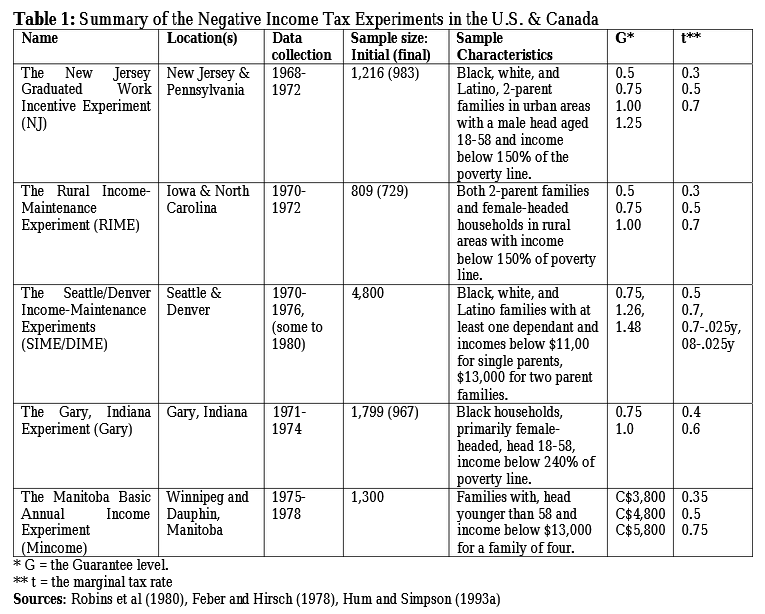
The question the 1970s NIT experiments were designed to mainly explore was what the impact on employment was of a 50% MTR compared to 30% and 70%, or in Gary, the difference between 40% and 60%. Seattle even tested a more complex phaseout involving a nonlinear function that imposed higher MTRs as high as 80% on lower incomes and reduced the MTR as people earned income. The amount of income provided was also tested to see how an amount that was 50% of the poverty line would compare to larger payments of 75%, 100%, 125%, and 148% of the poverty line.
In general, a higher amount of income paired with a higher MTR is expected to have stronger employment reduction effects than a lower amount of income paired with a lower MTR, but a higher amount will cost more, as will a lower MTR. So researchers at the time hoped to explore what could be expected from national implementation set at a certain amount and phaseout by running a bunch of pioneering experiments called the American Income Maintenance Experiments.
I'm not going to get into what the results were and instead just recommend reading Karl Widerquist's outstanding summary, but I will say that it helps to understand that an experiment designed to examine the impacts of a $500 monthly payment paired with a 0% MTR is going to likely increase employment compared to a control group (as it did in Stockton and in Hudson), versus a $1800/mo payment with a 70% MTR (Seattle and Denver) that's likely going to decrease employment, unless it's part of a saturation site like all of Alaska where an entire community having more money to spend results in the creation of more jobs for people to take due to increased consumer demand in the local economy.
The way most people look at UBI vs NIT is from the perspective of cost. A very serious economist will look you straight in the eye and tell you that a NIT is much cheaper than UBI because people get less money as they earn more, and obviously if the state is spending less money than it otherwise would, that's cheaper. But is that what's actually happening? Does a NIT spend less money? Does it cost less?
Consider two people. One of them is getting $600 a month in NIT and is faced with a 50% MTR. Another is getting $1200 a month in UBI and is faced with a 50% tax on earned income. Is the NIT cheaper? The answer is no. It just looks cheaper because their NIT payment was taxed at a 50% rate and it wasn't counted as a tax. But that's exactly what it was. It was an income tax applied to the recipient's payment instead of their wages. Both people were taxed $600 to get $1200. Both people end up with $600 more income because of the combination of payment and taxes. Both people face the same disincentive to work by losing 50 cents for every dollar earned in wages. Ignoring administrative cost, the cost to the government is the same for each person because in both instances, the government is down $600.
Administrative Differences
However, we can't ignore administrative cost. That's actually really important. In reality, there is going to be some amount of overhead to run a NIT program vs a UBI program, separate from the payments they provide. A NIT program is based on estimates of income. In order to calculate the amount of money you should get, the government needs to have some idea of what your income is. The most likely way to do this is to use your most recent tax return. Of course incomes can vary quite a bit, so an old tax return may show you have an income higher or lower than your actual income. Incomes can even vary by the month, which would also require the ability to report or track income changes month by month. This would necessitate some way for people to update their incomes each month. Variance in payments would also introduce errors, which would require adjustments where someone either gets more after getting too little, or has to pay back the amount that was greater than they should have gotten.
The closest policy to a NIT, and one actually inspired by it, is the earned income tax credit (EITC). Unlike a NIT which has only a phaseout, the EITC has both a phase-in and a phase-out, but also whereas a NIT would arrive monthly, the EITC currently only arrives once a year. Because the EITC is handled by the IRS, everyone who wants it needs to file a tax return. Because so many people need help with their tax returns, this also means people who qualify for the EITC lose 13% to 20% of their benefit in tax prep fees, resulting in an average overhead cost of 11%.
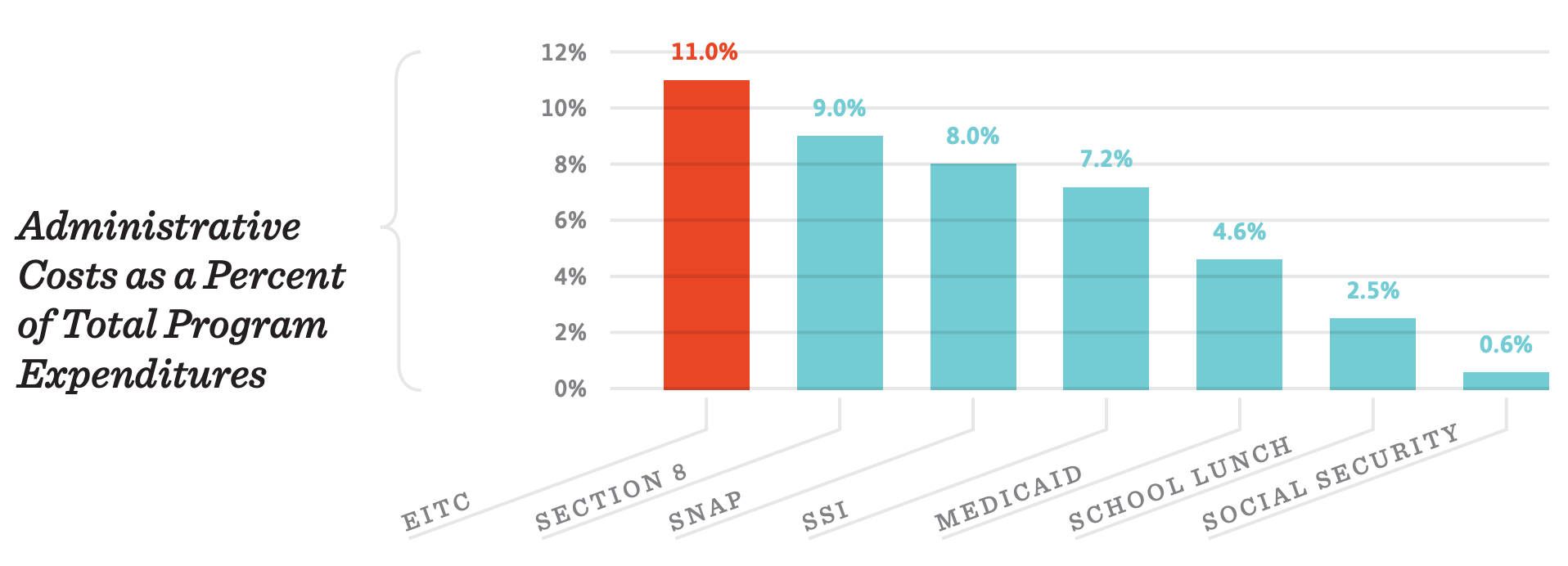
Now consider a UBI strategy. Everyone gets the same amount. No reporting or income tracking needed. No need for any additional overhead at all. The calculation is done at tax time using the same overhead as taxes already require. The overhead for Social Security is 0.5%. The overhead for UBI will likely be even lower than that and could be administrated by existing SSA infrastructure. It is extremely efficient to just direct deposit two hundred million payments, especially when the amounts are all identical.
Social Security's coverage is also superior to the EITC which on average excludes one out of every five people who is qualified to receive it based on income and miscalculates one out of four payments. It is fair to assume based on this reality that a NIT would also have a high error rate and also exclude a significant percentage of people in dire need that a UBI would not exclude, based purely on the reduced hurdles necessary to receive UBI via SSA versus IRS administration.
We should want to maximize the amount of money provided to recipients versus middlemen and minimize the amount of effort required to provide it. Based on the administrative capacity required to make the payments and correct any errors, a NIT and UBI of identical distributive outcomes are not identical in cost. The UBI approach is cheaper.
Marginal Tax Rate Differences
The biggest detail to fully understand though is how little sense it makes to apply a needlessly high MTR on recipients with low- and middle-incomes. The costs of NIT and UBI can be identical, but who pays the necessary taxes can be different, which can also mean differences in productivity, and thus economic growth. If a NIT that applies a 40% MTR to someone is compared with a UBI that applies a 10% MTR to that person instead, the net costs could be the same, but the NIT approach would have a worse work disincentive for that individual, making it possible for the NIT to reduce work and UBI to increase it.
There are also different growth impacts on the economy depending on who is doing the spending. If a NIT means someone in the bottom 20% gets less of a boost than they would with a UBI paired with progressive income taxes, then those economies are going to look different. The NIT economy is going to have more taxation at the bottom and middle. The UBI economy could have more taxation at the top, because a NIT phaseout is always going to impact those at the top less than UBI taxes, because the richest never pay any NIT phaseout taxes. Only those in the phaseout range do.
A real-world policy example to help illustrate the above points can be found in the enhanced child tax credit compared to a universal child allowance. The CTC utilized a phaseout tax of 5%. For married couples with kids, the tax hit those reporting incomes between $150,000 and $400,000. Had everyone within that range been taxed to achieve the same tax goal, not just parents, but childless adults too, the rate could have been more like 2%. Had everyone with incomes over $150,000 been taxed to achieve the same goal, such that those earning over $400,000 weren't excluded from being taxed, the MTR could have been under 1%.
If we're going to do a universal child allowance where every kid gets $300 a month, does it make more sense to apply a 5% MTR only to parents in the phaseout range (excludes the rich) or a 0.6% MTR to everyone above the desired phaseout starting point (includes the rich)? When you recognize phaseouts as taxes, it's easier to see that the question is really, "Should we find a way to tax the rich less by taxing the middle class more?" If your answer to that question is yes, then you should prefer phaseouts, and thus NIT or guaranteed income approaches. If you believe the increased tax burden should fall more on the rich than the middle class, then you should prefer the UBI approach more. That's just the inherent nature of universal programs compared to targeted programs.
How convenient is it for the rich that so many people mistakenly believe that targeted approaches are more progressive despite imposing less of a burden on the rich and providing less of a benefit to the middle class than universal approaches?
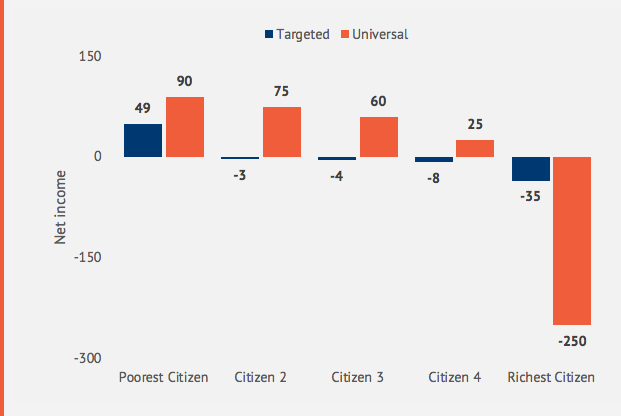
I really want to make sure no one walks away from reading this still not understanding that universal basic income is actually cheaper and can reduce inequality more than a negative income tax or a phased-out guaranteed income, so here's one more thought experiment to consider.
Imagine that five people sit down to play a game of Monopoly. They each start with different amounts of income which are: $0, $50, $100, $200, and $1,000. Let's say we want to implement a negative income tax as part of the game, such that players receive an income of $50 with a phaseout rate of 10%. Upon passing Go, player 1 would get $50. P2 would get $45. P3 would get $40. P4 would get $30. P5 would get $0 and pay a new $165 tax which is equal to a 16.5% tax.
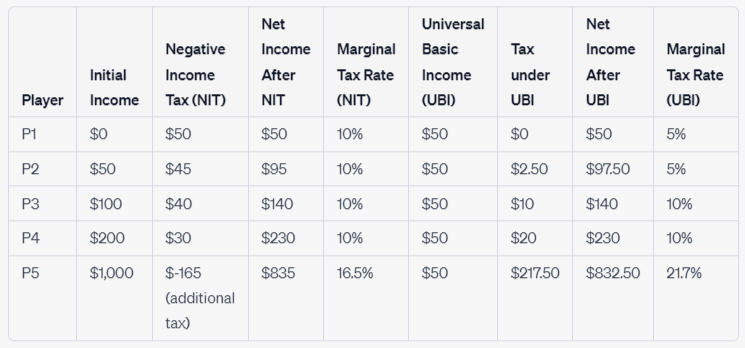
Compare this to a UBI approach where every player gets $50, but progressive taxation is applied such that P1 and P2 pay a 5% tax, P3 and P4 pay a 10% tax, and P5 pays a 21.7% tax. P1 would pay $0 in tax, P2 would pay $2.50, P3 would pay $10, P4 would pay $20, and P5 would pay $217.50. With this design, P5 has a higher tax burden and P1 and P2 get a lower tax burden because the phaseout taxes have been shifted upwards, leaving the players with the least income with a larger net benefit after taxes. Additionally players 1 and 2 face a smaller marginal tax rate of 5% instead of 10%. P5 faces a 21.7% MTR compared to a 16.5% MTR, and the effective tax rate on p5 is actually 16.75% because of their $50 UBI functioning as a tax credit. Is that enough for them to stop playing despite still having over three times the money of the second richest player? Is that more of a concern than P1 being too broke to even play the game?
Tax Method Differences
Perhaps my personal favorite reason to prefer UBI to NIT is the ability to utilize other taxes than income taxes. A NIT can be combined with any tax of course, but it will always actually be that tax plus a phaseout tax on income. A UBI can be designed to not utilize any income taxes at all, and instead utilize only taxes like a land value tax, or an automated payment transaction tax, or a progressive consumption tax, or a carbon tax, or any other Pigovian tax, or a value-added tax, or any other tax that isn't income tax. As AI advances and capital replaces labor, it will become increasingly important to tax things other than income. NIT can't escape income taxes. It will always tax income because it phases out based on income. Its fate is in its name - negative income tax.
As one example, consider a land value tax (LVT) which is not a tax on what's built on the land, but only the land itself. Milton Friedman considered it "the least bad tax." The tax rate of LVT imposed on anyone who doesn't own any land is zero. Consider the difference in land ownership between wealthy individuals/corporations and Black communities who have suffered centuries of systemic exclusion from home ownership. All renters would face a marginal tax rate of 0%. All landowners would only see an increase in their taxes if they bought more land, not if they worked more. Because the value of land is created by the community and all the stuff around it, it makes the most sense to share that value equally (UBI). What would make less sense is to vary the amount provided to the community by income and in doing so impose an entirely unnecessary marginal tax rate on income (NIT).
Another example is any kind of consumption tax. Everyone could work more and not get taxed more. Instead, taxes would go up with consumption. The more money people would spend, the more tax they would pay. The more people saved or invested, the less tax they would pay. Combined with UBI, those who consumed the least would end up keeping more of their UBI and earned income while those who consumed the most would end up losing more of their UBI and earned income. Consider a 10% VAT and a $15,000 UBI. That could potentially mean everyone spending less than $150,000 would end up with a net benefit from UBI, and everyone spending more would end up paying more in taxes. The combination is essentially a negative consumption tax. Utilizing NIT with VAT instead of UBI would impose an entirely unecessary marginal tax rate on income.
Consider too the case of Alaska and their UBI in the form of an annual dividend that has been distributed since 1982. Imagine if they had tried to distribute oil revenue as a NIT? It may have even been deemed unconstitutional just as their original plan to vary payments by length of residency was deemed to violate equal protection rights before they then decided to distribute payments equally.
It just makes more sense to use UBI with tax methods other than income taxes.
Psychological Differences
There's also one more reason to prefer UBI to NIT or GI, and it's a psychological reason. Losing benefits hurts more than paying taxes. It's not psychologically equivalent to lose $10 from your NIT as it is to keep $20 in UBI and lose $10 from taxes.
In an experiment conducted at the University of Essex, subjects were required to do a task in exchange for payments, which were taxed. One group paid the tax out of a cash benefit they received up-front (NIT condition), and another group paid the tax out of their earnings for the task (UBI condition). It should not matter where the tax comes from if the net result is the same, but it did. Those who were asked to pay the tax from their up-front benefit rather than from their earnings were around three times more likely to quit working early. One possible explanation for this finding is loss aversion, where people are more averse to losing what they have than gaining something new. Applying this to NIT and UBI means that even with an identical outcome and marginal tax rate, it's possible that people could be less motivated to increase their incomes by seeing their NIT shrink compared to a UBI that never shrinks. More research is needed.
Political Differences
With all of the above said, there is one reason that a NIT could be seen as superior to UBI, and it's the political realities of the national context in which the two policies are being discussed. Most people will never read this post or ever fully understand just how similar these two policies are and for what reasons UBI edges out NIT. It therefore may just be more politically possible to pass a NIT into law based on the lack of understanding of UBI. I don't see that as optimal, but I do see it as far better than lacking either one.
On the other hand, a UBI could still be more politically popular by going to everyone and being widely viewed as an earned dividend and inheritance. If the discussion driving basic income discussion is centered around AI, a lack of understanding of UBI and NIT could still result in a preference for universality. If AI is seen as something we all collectively trained, and the technology behind it is seen as something we've all inherited from those who came before us, does NIT make sense as a mechanism of fairly distributing the benefits to everyone?
Conclusion
I hope at this point it's now clear that for any NIT and UBI designed to be identical in distributive impact, the UBI is technically cheaper due to lower administrative costs, and that every NIT and phased-out GI design imposes a tax on those with lower and middle incomes that a UBI could instead shift onto those with higher incomes. The UBI approach also need not tax anyone's income at all and recognizes loss aversion psychology. It can even be communicated as a dividend.
Although very similar to a negative income tax (NIT), an unconditional universal basic income (UBI) is simply a better way of going about boosting incomes, decreasing marginal tax rates for those with low- and middle-incomes, and increasing taxes on those earning, consuming, and owning the most - aka the rich.
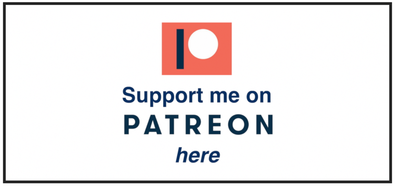
Do you want more content like this? Please click the subscribe button and also consider making a monthly pledge in support of my ongoing UBI advocacy.
Special thanks to my monthly supporters on Patreon: Gisele Huff, Haroon Mokhtarzada, Steven Grimm, Matthew Cheney, Katie Moussouris, Tricia Garrett, Zack Sargent, David Ruark, Larry Cohen, Liya Brook, Frederick Weber, John Steinberger, Laurel gillespie, Dylan J Hirsch-Shell, Tom Cooper, Judith Bliss, Robert Collins, Daryl Smith, Joanna Zarach, ace bailey, Daragh Ward, Albert Wenger, Bruce Allen, Bridget I Flynn, Peter T Knight, David Ihnen, Max Henrion, Elizabeth Corker, Gray Scott, Gerald Huff, Albert Daniel Brockman, Michael Honey, Natalie Foster, Joe Ballou, Chris Rauchle, Arjun , Leslie Kausch, Jessica Chew, Braden Ferrin , Deanna McHugh, chris heinz, Pavel S, Zachary Weaver, Herb, Justin Seifert, Jodi Sarda, Rosa Tran, Ryan Ash-Miller, miki, Adam Parsons, bradzone, Lee Lor, Akber Khan, John Sullivan, Team TJ, Yang Deng, Yan Xie, Marie janicke, engageSimply - Judy Shapiro, Garry Turner, Tim , Warren J Polk, Timothy P O'Connor, Jeffrey Emmett, Stephen Castro-Starkey, Oliver Bestwalter, Kev Roberts, Walter Schaerer, Loren Sickles, anti666, Eric Skiff, Thomas Welsh, Kai Wong, and Laura Ashby. Become a monthly patron to see your name here too!
_large.jpg)
UBI Guide Newsletter
Join the newsletter to receive the latest updates in your inbox.



